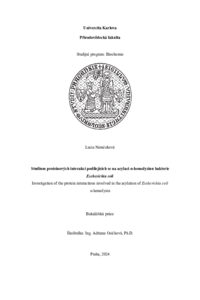Studium proteinových interakcí podílejících se na acylaci α-hemolyzinu bakterie Escherichia coli
Investigation of the protein interactions involved in the acylation of Escherichia coli α-hemolysin
bachelor thesis (DEFENDED)

View/
Permanent link
http://hdl.handle.net/20.500.11956/190687Identifiers
Study Information System: 264619
Collections
- Kvalifikační práce [20329]
Author
Advisor
Referee
Šulc, Miroslav
Faculty / Institute
Faculty of Science
Discipline
Biochemistry
Department
Department of Biochemistry
Date of defense
11. 6. 2024
Publisher
Univerzita Karlova, Přírodovědecká fakultaLanguage
Czech
Grade
Excellent
Keywords (Czech)
α-hemolyzin HlyA, acyltransferasa, posttranslační modifikace, acyl carrier protein, bakteriální dvouhybridový systémKeywords (English)
α-hemolysin HlyA, acyltransferase, posttranslational modification, acyl carrier protein, bacterial two-hybrid systemUropatogenní bakterie Escherichia coli jsou primární příčinou infekcí močového traktu. Jedním z faktorů virulence těchto bakterií je α-hemolyzin (HlyA), který patří mezi cytolytické RTX (Repeats in ToXin) toxiny sekretované některými gramnegativními patogenními bakteriemi. RTX toxiny sdílí několik charakteristických strukturních a funkčních domén a segmentů: (1) N-koncovou hydrofobní doménu tvořící membránové póry, (2) acylovaný segment, v němž jsou dva lysinové zbytky modifikovány řetězci mastných kyselin, (3) repetitivní (RTX) doménu vázající vápenaté ionty a (4) C-koncový sekreční signál, který je rozpoznáván sekrečním systémem typu 1. HlyA je syntetizován jako neaktivní protoxin (proHlyA), k jehož aktivaci dochází kovalentní acylací ε-aminoskupiny dvou konzervovaných lysinových zbytků, K564 a K690, pomocí koexprimované acyltransferasy HlyC. Jako donor acylového řetězce slouží acyl-acyl carrier protein (acyl-ACP). Molekulární mechanismus, kterým acyltransferasa HlyC interaguje s acyl-ACP a proHlyA je prozatím jen málo prozkoumán. Cílem předkládané bakalářské práce bylo nalézt aminokyselinové zbytky účastnící se interakce mezi proteiny HlyC a ACP. Na základě in silico interakčního modelu HlyC s ACP byly v HlyC predikovány kladně nabité zbytky a v ACP negativně nabité zbytky, které by se mohly...
Uropathogenic bacteria Escherichia coli are the primary cause of urinary tract infections. One of the virulence factors of these bacteria is α-hemolysin (HlyA), a protein belonging to the cytolytic RTX (Repeats in ToXin) toxins secreted by some gram-negative pathogenic bacteria. RTX toxins share several characteristic structural and functional domains and segments: (1) an N-terminal hydrophobic pore-forming domain, (2) an acylated segment where two lysine residues are modified by fatty acid chains, (3) a repetitive (RTX) domain binding calcium ions, and (4) a C-terminal secretion signal recognized by the type 1 secretion system. HlyA is synthesized as an inactive protoxin (proHlyA), which is activated by covalent acylation of the ε-amino groups of two conserved lysine residues, K564 and K690, by the co-expressed acyltransferase HlyC. Acyl-acyl carrier protein (acyl-ACP) serves as the acyl chain donor. However, the molecular mechanism by which the acyltransferase HlyC interacts with acyl-ACP and proHlyA is currently poorly understood. The aim of this bachelor thesis was to identify amino acid residues involved in the interaction between HlyC and ACP proteins. Based on an in silico interaction model of HlyC and ACP, positively charged residues in HlyC and negatively charged residues in ACP were...
